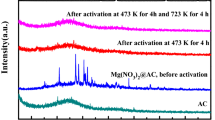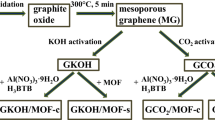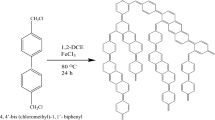Abstract
Metal-organic frameworks (MOFs) have been recognized as promising adsorbents for carbon capture due to their ultrahigh surface areas and tunable properties. However, a majority of MOFs have strict requirements for preparation and high mass transfer resistance that limits the gas separation time. In order to improve the applicability of MOFs to practical applications, herein, we reported an experimental approach to prepare structured CuBTC/graphene aerogel (GA) composites using ionic liquid (IL) additives (CuBTC/GA-IL) at room temperature for CO2 capture. The material was characterized by powder X-ray diffraction (PXRD), scanning electron microscopy (SEM), specific surface area analysis, and CO2 adsorption tests. It was demonstrated that CuBTC/GA-IL exhibited the higher CO2 uptake than CuBTC/GA prepared without IL additives. Besides, the breakthrough experiments have shown that CuBTC/GA-IL exhibited the lower mass transfer resistance compared with CuBTC-IL and good cyclability. The effective approach of fabricating CuBTC into GA using IL additives to improve CO2 adsorption in this study may be extensively applied for other MOF-based composites.

Graphical abstract





Similar content being viewed by others
Data availability
All data generated or analyzed during this study are included in this published article and its supplementary information file.
Abbreviations
- rGO:
-
reduced graphene oxide
- GA:
-
graphene aerogel
- ZIF:
-
zeolitic imidazolate framework
- Zr:
-
zirconium
- MIL:
-
Matériaux de l’Institut Lavoisier
- BTC:
-
benzene-1,3,5-tricarboxylate
- MOFs:
-
metal-organic frameworks
- DMF:
-
N, N-dimethylformamide
- SEM:
-
scanning electron microscopy
- PXRD:
-
powder X-ray diffractometer
References
Anbia M, Hoseini V (2012) Development of MWCNT@MIL-101 hybrid composite with enhanced adsorption capacity for carbon dioxide. Chem Eng J 191:326–330
Bian Z, Zhu X, Jin T, Gao J, Hu J, Liu H (2014) Ionic liquid-assisted growth of Cu3(BTC)2 nanocrystals on graphene oxide sheets: towards both high capacity and high rate for CO2 adsorption. Microporous Mesoporous Mater 200:159–164
Boothandford ME et al (2014) Carbon capture and storage update. Energy Environ Sci 7:130–189
Chen C, Feng N, Guo Q, Li Z, Li X, Ding J, Wang L, Wan H, Guan G (2018) Template-directed fabrication of MIL-101(Cr)/mesoporous silica composite: layer-packed structure and enhanced performance for CO2 capture. J Colloid Interface Sci 513:891–902
Chui SS-Y, Lo SM-F, Charmant JPH, Orpen AG, Williams ID (1999) A chemically functionalizable nanoporous material [Cu3(TMA)2(H2O)3]n. Science 283:1140–1150
Furtado AMB, Liu J, Wang Y, LeVan MD (2011) Mesoporous silica–metal organic composite: synthesis, characterization, and ammonia adsorption. J Mater Chem 21:6698–6706
Garcia S, Gil M, Martín C, Pis J, Rubiera F, Pevida C (2011) Breakthrough adsorption study of a commercial activated carbon for pre-combustion CO2 capture. Chem Eng J 171:549–556
Ge L, Wang L, Rudolph V, Zhu Z (2013) Hierarchically structured metal–organic framework/vertically-aligned carbon nanotubes hybrids for CO2 capture. RSC Adv 3:25360–25366
Gibbins, Chalmers J, Hannah (2008) Carbon capture and storage. Energy Policy 36:4317–4322
Gorka J, Fulvio PF, Pikus S, Jaroniec M (2010) Mesoporous metal organic framework-boehmite and silica composites. Chem Commun (Camb) 46:6798–6800
Inonu Z, Keskin S, Erkey C (2018) An emerging family of hybrid nanomaterials: metal–organic framework/aerogel composites. ACS Appl Nano Mater 1:5959–5980
Jiang M, Li H, Zhou L, Xing R, Zhang J (2018) Hierarchically porous graphene/ZIF-8 hybrid aerogel: preparation, CO2 uptake capacity, and mechanical property. ACS Appl Mater Interfaces 10:827–834
Li J et al (2011) Carbon dioxide capture-related gas adsorption and separation in metal-organic frameworks. Coord Chem Rev 255:1791–1823
Li G, Pang S, Wu Y, Ouyang J (2018a) Enhanced removal of hydroquinone by graphene aerogel-Zr-MOF with immobilized laccase. Chem Eng Commun 205:698–705
Li H, Wang K, Sun Y, Lollar CT, Li J, Zhou H-C (2018b) Recent advances in gas storage and separation using metal–organic frameworks. Mater Today 21:108–121
Liu H-S, Lan Y-Q, Li S-L (2010) Metal−organic frameworks with diverse structures constructed by using capsule-like ligand and NiII based on ionothermal and hydrothermal methods. Cryst Growth Des 10:5221–5226
Liu Y, Ghimire P, Jaroniec M (2019) Copper benzene-1,3,5-tricarboxylate (Cu-BTC) metal-organic framework (MOF) and porous carbon composites as efficient carbon dioxide adsorbents. J Colloid Interface Sci 535:122–132
Mao J, Ge M, Huang J, Lai Y, Lin C, Zhang K, Meng K, Tang Y (2017) Constructing multifunctional MOF@rGO hydro-/aerogels by the self-assembly process for customized water remediation. J Mater Chem 5:11873–11881
Myers AL, Prausnitz JM (1965) Thermodynamics of mixed-gas adsorption. AICHE J 11:121–127
Na L, Zhang L, Zhang W, Hua R (2015) Room temperature synthesis and characterization of metal-organic framework Cu3(BTC)2. Gongneng Cailiao/J Funct Mater 46:12079–12081
Qiu L et al (2008) Hierarchically micro-and mesoporous metal-organic frameworks with tunable porosity. Angew Chem 47:9487–9491
Rezaei F, Webley PA (2010) Structured adsorbents in gas separation processes. Sep Purif Technol 70:243–256
Rezaei F, Mosca A, Webley P, Hedlund J, Xiao P (2010) Comparison of traditional and structured adsorbents for CO2 separation by vacuum-swing adsorption. Ind Eng Chem Res 49:4832–4841
Riaz MA, Hadi P, Abidi IH, Tyagi A, Ou X, Luo Z (2017) Recyclable 3D graphene aerogel with bimodal pore structure for ultrafast and selective oil sorption from water. RSC Adv 7:29722–29731
Shang W, Kang X, Ning H, Zhang J (2013) Shape and size controlled synthesis of MOF nanocrystals with the assistance of ionic liquid mircoemulsions. Langmuir 29:13168–13174
Trickett CA, Helal A, Al-Maythalony BA, Yamani ZH, Cordova KE, Yaghi OM (2017) The chemistry of metal–organic frameworks for CO2 capture, regeneration and conversion. Nat Rev Mater 2:1–16
Wang X-S, Ma S, Sun D, Parkin S, Zhou H-C (2006) A mesoporous metal−organic framework with permanent porosity. J Am Chem Soc 128:16474–16475
Wang B, Xie L-H, Wang X, Liu X-M, Li J, Li J-R (2018) Applications of metal–organic frameworks for green energy and environment: new advances in adsorptive gas separation, storage and removal. Green Energy Environ 3:191–228
Xiang Z, Peng X, Cheng X, Li X, Cao D (2011) CNT@Cu3(BTC)2 and metal–organic frameworks for separation of CO2/CH4 mixture. J Phys Chem C 115:19864–19871
Xiang S, He Y, Zhang Z, Wu H, Zhou W, Krishna R, Chen B (2012) Microporous metal-organic framework with potential for carbon dioxide capture at ambient conditions. Nat Commun 3:1–9
Ye R, Ni M, Xu Y, Chen H, Li S (2018) Synthesis of Zn-based metal–organic frameworks in ionic liquid microemulsions at room temperature. RSC Adv 8:26237–26242
Yu J, Xie LH, Li JR, Ma Y, Seminario JM, Balbuena PB (2017) CO2 capture and separations using MOFs: computational and experimental studies. Chem Rev 117:9674–9754
Zhang X, Liang Q, Han Q, Wan W, Ding M (2016) Metal-organic frameworks@graphene hybrid aerogels for solid-phase extraction of non-steroidal anti-inflammatory drugs and selective enrichment of proteins. Analyst 141:4219–4226
Zhao Y, Zhang J, Han B, Song J, Li J, Wang Q (2011) Metal–organic framework nanospheres with well-ordered mesopores synthesized in an ionic liquid/CO2/surfactant system. Angew Chem Int Ed 50:636–639
Acknowledgments
We thank the Analytical & Testing Center of Huazhong University of Science and Technology for the support.
Funding
This work was funded by the National Natural Science Foundation of China (NSFC) under Project Nos. 51836003 and 51606081.
Author information
Authors and Affiliations
Corresponding author
Ethics declarations
Conflict of interest
The authors declare that they have no conflict of interest.
Additional information
Publisher’s note
Springer Nature remains neutral with regard to jurisdictional claims in published maps and institutional affiliations.
Wen Ren and Zhenzhen Wei are co-authors.
Electronic supplementary material
ESM 1
(DOCX 923 kb)
Rights and permissions
About this article
Cite this article
Ren, W., Wei, Z., Xia, X. et al. CO2 adsorption performance of CuBTC/graphene aerogel composites. J Nanopart Res 22, 191 (2020). https://doi.org/10.1007/s11051-020-04933-4
Received:
Accepted:
Published:
DOI: https://doi.org/10.1007/s11051-020-04933-4




